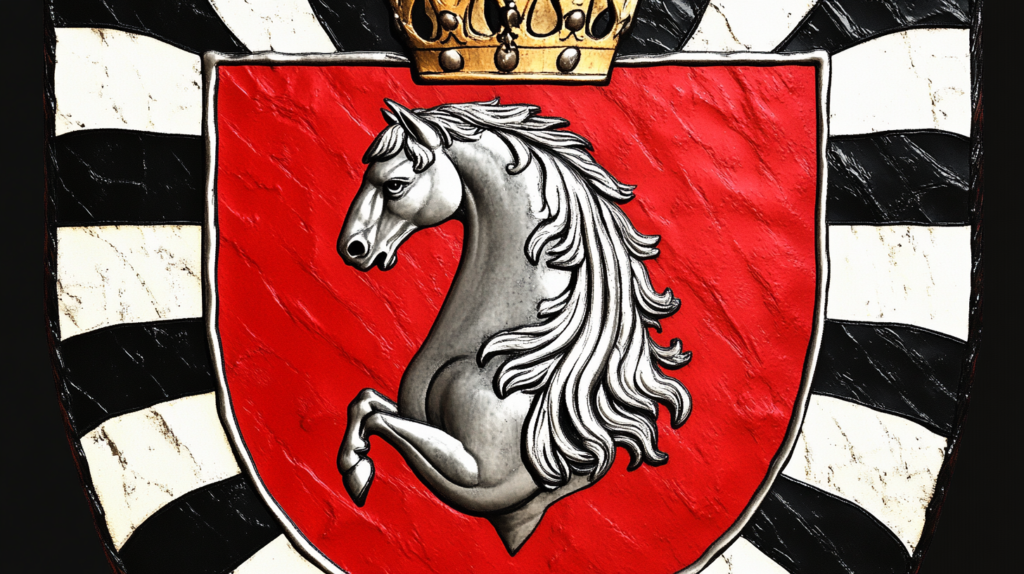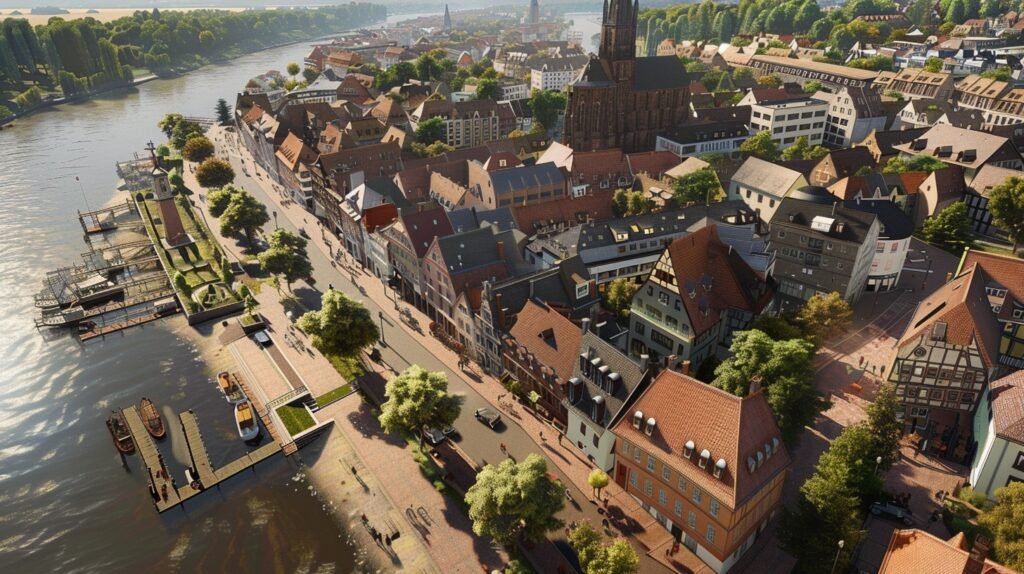
Coat of Arms Kreis Herzogtum Lauenburg (Duchy of Lauenburg)
- Origins of the Coat of Arms: The horse head symbol, which became the emblem of the Duchy of Lauenburg, originated during the redesign of the Danish state coat of arms after the Napoleonic era. Lauenburg was transferred from the Kingdom of Hanover to the Kingdom of Denmark in 1816. The horse head was initially golden to distinguish it from the “Welfenroß” (a symbol associated with the House of Welf).
- Danish and Prussian Influence: During its time under Danish rule, the horse head was used in the Danish state coat of arms, symbolizing that Denmark had no further claims on Hanoverian territory. After Prussia took over the Duchy in 1865, the coat of arms was modified to include a shield with alternating silver and black segments, reflecting Prussian sovereignty. A Prussian royal crown was also added.
- Official Adoption: The coat of arms was officially granted on 12 November 1866 by King Wilhelm I of Prussia. However, the Kreis (district) could only officially use it around 1925, as Prussian regulations initially prohibited districts from having their own coats of arms.
- Post-1918 Changes: After the fall of the monarchy in 1918, the Weimar Republic allowed districts to adopt their own coats of arms. The Kreis Herzogtum Lauenburg then began using the historical coat of arms, which features a silver horse head on a red shield with a silver and black border, topped by a golden crown.
In summary, the coat of arms of Kreis Herzogtum Lauenburg reflects the region’s historical ties to Denmark and Prussia, with the horse head symbolizing its unique identity within these larger political entities.
Herzogtum Lauenburg: A Historical and Modern Portrait
Nestled in the southeastern corner of Schleswig-Holstein, Germany, Kreis Herzogtum Lauenburg—often simply called the Duchy of Lauenburg—blends a rich historical tapestry with a serene rural charm. Named after the medieval Duchy of Saxe-Lauenburg, this district borders Hamburg, Lübeck, Mecklenburg-Vorpommern, and Lower Saxony, with the river Elbe tracing its southern edge. Its story spans centuries of shifting allegiances, economic evolution, and a quiet resilience that defines it today.

Historical Context: Autonomy Under the Danish Crown
The roots of Herzogtum Lauenburg stretch back to 1296, when the Duchy of Saxe-Lauenburg emerged from the partition of the larger Duchy of Saxony. By the early modern era, its fortunes shifted dramatically. From 1689 to 1816, it fell under the influence of the Electorate of Brunswick-Lüneburg (Hannover), but the Congress of Vienna in 1815 redrew the map, ceding it to Denmark. From 1815 to 1864, Lauenburg existed as a somewhat autonomous entity in personal union with the Danish Crown, ruled by the Danish king but not fully integrated into Denmark proper. This autonomy was reflected in its status within the German Confederation, where the Danish monarch represented it as a distinct duchy, separate from Denmark’s core territories.
During this period, Lauenburg retained its own constitution, laws, and the influential Ritter- und Landschaft (nobility and estates), which managed local affairs. The Danish era also shaped its heraldic identity: the golden horse head, adopted in 1816 to distinguish it from Hannover’s Welfenroß, symbolized both its heritage and Denmark’s limited territorial ambitions beyond Lauenburg. This autonomy ended abruptly in 1864, when Prussia and Austria seized it after the Second Schleswig War. By 1865, it entered a personal union with Prussia, and in 1876, it was fully incorporated as a district into the Prussian Province of Schleswig-Holstein, losing its ducal independence but retaining the evocative “Herzogtum” title as a nod to its past.
Traditional Economic Activities
Historically, Lauenburg’s economy thrived on its natural endowments and strategic location along the Elbe. Agriculture dominated, with fertile lands supporting cereal crops like rye and barley, alongside dairy farming—a legacy of the manorial system that persisted into the 18th century. The river Elbe, flowing from Lauenburg town to the North Sea, fueled a bustling trade in timber, grain, and salt, linking the duchy to broader European markets via the Old Salt Route and, later, the Elbe-Lübeck Canal (completed in 1900). Fishing supplemented rural livelihoods, while small-scale crafts—blacksmithing, weaving, and pottery—flourished in towns like Ratzeburg and Mölln.
The nobility’s manorial estates, worked by feudal peasants until serfdom’s abolition in 1805, drove economic output, particularly in dairy and livestock. Lauenburg upon Elbe, the duchy’s first capital until 1619, was a hub for riverine commerce, its harbor teeming with merchants and boatmen. This blend of agrarian stability and waterway trade sustained the region through its Danish and Prussian phases, even as political upheavals reshaped its governance.

Current Overview
Today, Kreis Herzogtum Lauenburg is a tranquil district of roughly 200,000 residents, part of the Hamburg Metropolitan Region yet distinct in its rural character. The economy has diversified but retains agrarian roots: agriculture remains vital, with modern farms producing crops, dairy, and meat, often marketed as organic or regional specialties. Tourism has emerged as a cornerstone, especially in the Lauenburg Lakes Nature Park, where Ratzeburger See—the largest of over 40 lakes—draws visitors for boating, hiking, and cycling. The district’s proximity to Hamburg fuels a “bacon belt” commuter culture, with many residents working in the city while enjoying Lauenburg’s lower costs and greenery.
Industry plays a modest role, with Geesthacht hosting technological firms and historical echoes of innovation (like its past as a dynamite production site). The Elbe still supports shipping, though its economic dominance has waned. Culturally, the area celebrates its heritage through museums, like the Lauenburg Castle tower, and festivals in towns like Mölln, tied to the jester Till Eulenspiegel. Its forest-rich landscape, including the vast Sachsenwald, adds to its appeal as a peaceful retreat from urban bustle.
Day-Trip Guidance for the Casual Visitor
For a day trip from Hamburg (just 45 minutes by car or train), Kreis Herzogtum Lauenburg offers a compact yet enriching escape. Start in Ratzeburg, a picturesque island town encircled by Ratzeburger See. Visit the Romanesque Ratzeburg Cathedral, built by Henry the Lion in the 12th century, then stroll the waterfront promenade—rent a pedal boat (€10-15/hour) for a lake adventure if weather permits (spring to autumn is ideal). Grab a coffee and pastry at a lakeside café like Café am Markt.
Next, head 20 minutes south to Mölln, the “Eulenspiegel town.” Explore the Till Eulenspiegel Museum (€4 entry) to dive into the trickster’s lore, then wander the old town’s half-timbered streets. Lunch at Zum Alten Fritz—try the local schnitzel or freshwater fish (€12-18). If time allows, drive 15 minutes to Lauenburg an der Elbe, a riverside gem. Climb the bluff to the Lauenburg Castle tower (free entry) for Elbe views, and peek at the historic Palmschleuse lock. End with a riverside walk along the harbor, perhaps with an ice cream from a local stand.
Tips: Trains from Hamburg Hauptbahnhof to Büchen connect to Ratzeburg and Mölln (HVV tickets, ~€10 round-trip). Driving gives flexibility—take the A24 south. Wear comfy shoes for cobbled streets, and check event schedules (e.g., Mölln’s Eulenspiegel Festival in summer). Pack light; the day’s charm lies in its laid-back pace.
Top 3 for Herzogtum Lauenburg
- Ratzeburg Cathedral (Dom zu Ratzeburg)
In Ratzeburg, this 12th-century Romanesque beast sits on an island in the Ratzeburger See, linked by causeways. Built by Henry the Lion, it’s brick-built—classic north German style—with a cloister that’s eerily peaceful and a tower offering views over the lake’s glassy expanse. The interior’s sparse but striking, with arched ceilings and a sense of weighty history. It’s not as grand as Lübeck’s churches, but its isolation and age give it a quiet power. The town’s worth a wander too—half-timbered houses and a sleepy pace. - Lauenburg Old Town and Elbe Waterfront
Lauenburg an der Elbe, the district’s namesake, clings to a bluff overlooking the Elbe River. The old town’s a jumble of steep streets and crooked, colorful houses, some dating back to the 17th century when this was a shipping hub. The waterfront’s the soul of it—old cranes, a maritime museum in a former warehouse, and the Elbe’s slow roll toward Hamburg. You can hop a ferry across or just watch the barges glide by. It’s got a faded-glory feel, rough around the edges but full of character. - Mölln and Till Eulenspiegel Legacy
Mölln’s a lakeside town tied to Till Eulenspiegel, the medieval trickster immortalized in folklore. The Till Eulenspiegel Fountain—him grinning with an owl and mirror—sits in the market square, and a small museum digs into his pranks (some say he died here in 1350). Beyond the legend, Mölln’s got charm: cobbled streets, a Gothic brick church (St. Nicolai), and the Möllner See for a quick boat trip. It’s quaint but not cloying, with a bit of mischief in its bones.
Bonus Tip – An Under the Radar Destination: Gudow
Tucked in the district’s east near the Schaalsee Biosphere Reserve, Gudow’s a speck of a village that barely registers on most maps. It’s got a serene lake—Großer Gudower See—rimmed by woods, perfect for a swim or a lazy paddle in summer. The old manor house, now a private retreat, adds a hint of faded nobility, and the surrounding trails dip into the biosphere’s quiet wilds—think deer, cranes, and no crowds. It’s not a tourist draw; it’s a place to breathe, maybe fish, and let the world slip away. Late spring’s prime, when the forest wakes up.